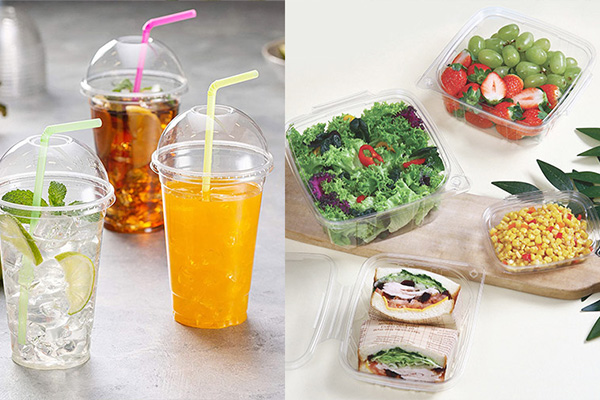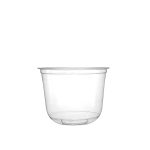Quick Summary:
This article explores France’s perspective on RPET/PET single-use eco-friendly packaging, highlighting the environmental benefits, government regulations, consumer attitudes, and the role of these materials in reducing plastic waste. With the growing demand for sustainable packaging solutions, RPET and PET are helping France transition to a circular economy and reduce its carbon footprint.
Introduction: The Growing Importance of Sustainable Packaging in France
In recent years, sustainability has become a central focus for businesses, consumers, and governments around the world, and France is no exception. The French packaging industry is undergoing a significant transformation, with increasing emphasis on eco-friendly packaging solutions, including RPET (Recycled PET) and PET (Polyethylene Terephthalate) materials. These materials, known for their recyclability and reduced environmental impact, are increasingly being seen as viable alternatives to traditional packaging options.
This article delves into France’s perspective on RPET/PET single-use eco-friendly packaging, exploring government policies, consumer trends, and industry developments that are driving the demand for these sustainable solutions. We will also examine how businesses in France are adopting RPET/PET packaging to align with environmental goals, reduce waste, and meet consumer expectations.
The Rise of RPET and PET in France
What Is RPET and PET?
RPET (Recycled PET) and PET (Polyethylene Terephthalate) are both types of plastic that have gained attention in the packaging industry due to their recyclability and lower environmental impact compared to other plastics. PET is widely used in food and beverage packaging, while RPET is made from recycled PET bottles, making it an eco-friendly option for businesses looking to reduce their carbon footprint.
RPET is particularly popular for single-use packaging, as it reduces the need for virgin plastic and can be recycled multiple times, contributing to a circular economy. PET, while still a single-use material, is one of the most recyclable plastics and is increasingly being used in the production of sustainable packaging solutions.
France’s Commitment to Sustainable Packaging
France has long been a leader in environmental policies, and this extends to its approach to packaging materials. The French government has introduced various regulations and initiatives aimed at reducing plastic waste and promoting sustainable packaging options, such as the Anti-Waste and Circular Economy Law (AGEC) introduced in 2020. This law mandates that all packaging materials must be recyclable or reusable by 2025, which has created a strong push for RPET and PET packaging.
In addition to government regulations, French consumers are also becoming more aware of the environmental impact of packaging. According to recent studies, more than 70% of French consumers are willing to pay a premium for products packaged in eco-friendly materials like RPET and PET, further driving demand for sustainable packaging solutions.

The Environmental Benefits of RPET/PET Single-Use Eco-Friendly Packaging
Reducing Plastic Waste
One of the main advantages of RPET/PET single-use eco-friendly packaging is its ability to reduce plastic waste. By recycling PET bottles into new packaging materials, businesses can significantly lower their reliance on virgin plastic. This not only helps reduce plastic pollution but also conserves valuable resources, making RPET/PET packaging an essential part of France’s strategy to combat plastic waste.
Lower Carbon Footprint
Manufacturing packaging materials from RPET generally requires less energy than producing virgin PET. This reduction in energy consumption leads to a lower carbon footprint, contributing to France’s overall climate goals. Moreover, because RPET is made from recycled materials, it requires fewer raw materials, which helps reduce the environmental impact of extracting and processing new resources.
Circular Economy and Recycling Initiatives
France is heavily invested in promoting a circular economy, where products and materials are reused, refurbished, and recycled to keep them in circulation for as long as possible. The use of RPET supports this model by ensuring that packaging materials are continuously recycled and repurposed, reducing the need for landfilling or incineration.
Government Regulations and Policies Supporting RPET/PET Packaging in France
The Anti-Waste and Circular Economy Law (AGEC)
The AGEC law, passed in 2020, outlines France’s ambitious plan to reduce plastic waste and promote a circular economy. Among its key provisions are the requirements for packaging to be 100% recyclable or reusable by 2025. This has created a strong push for the adoption of RPET and PET packaging in industries such as food and beverage, cosmetics, and retail. Under the law, companies are encouraged to increase the use of recycled content in packaging and reduce single-use plastics.
Extended Producer Responsibility (EPR)
France has also implemented Extended Producer Responsibility (EPR) programs, which hold manufacturers accountable for the recycling and disposal of their packaging. These programs incentivize companies to use recyclable and sustainable packaging materials like RPET and PET, as they are easier to collect and recycle compared to other types of plastic.
Consumer Attitudes Toward Eco-Friendly Packaging in France
Growing Demand for Sustainable Products
As global awareness of environmental issues increases, French consumers are placing more importance on sustainable packaging. A report by France Nature Environnement found that nearly 80% of French consumers believe that brands should prioritize using eco-friendly packaging. This trend is particularly evident in the food and beverage sector, where products packaged in RPET and PET are gaining popularity for their environmentally friendly attributes.
Transparency and Brand Image
French consumers are also demanding more transparency from brands regarding their environmental practices. Brands that use eco-friendly materials like RPET and PET in their packaging can enhance their reputation and appeal to eco-conscious consumers. Companies that actively promote their use of sustainable materials are more likely to be favored by consumers who value environmental responsibility.

The Role of RPET/PET Packaging in France’s Food and Beverage Industry
Sustainability in Food Packaging
In France, the food and beverage industry is one of the largest consumers of single-use packaging, including plastic bottles, containers, and trays. The shift toward RPET packaging is particularly important in this sector, as it reduces the environmental impact of packaging waste. Many leading French food brands have already committed to using RPET for their packaging, and this trend is expected to accelerate in the coming years as more regulations are introduced to reduce plastic waste.
Challenges in the Adoption of RPET/PET
Despite the environmental benefits of RPET/PET, there are still challenges to its widespread adoption. One of the main concerns is the availability of high-quality recycled PET, as the recycling process can sometimes result in lower-quality materials. However, as recycling technologies improve and consumer demand for eco-friendly packaging grows, the supply of high-quality RPET is expected to increase.
FAQ: Everything You Need to Know About RPET/PET Eco-Friendly Packaging in France
Q1: What is RPET and PET packaging?
A1:
RPET (Recycled PET) is made from recycled plastic bottles, making it an eco-friendly alternative to virgin PET. PET (Polyethylene Terephthalate), on the other hand, is a widely used plastic known for its strength and recyclability. Both materials are commonly used for single-use eco-friendly packaging, especially in food and beverage containers.
Q2: Why is France focusing on RPET and PET packaging?
A2:
France is committed to reducing plastic waste and promoting sustainability. The French government has implemented regulations that require packaging materials to be recyclable or reusable by 2025. This has pushed businesses toward adopting RPET/PET packaging, which is recyclable and can be made from recycled materials, contributing to a circular economy.
Q3: Are RPET and PET packaging recyclable?
A3:
Yes, both RPET and PET are highly recyclable materials. RPET is made from recycled plastic bottles, and it can be reused multiple times to create new packaging. PET is one of the most recyclable plastics, and with the right infrastructure, both materials can be recycled into new packaging, reducing the need for virgin plastic.
Q4: How does RPET/PET packaging help reduce plastic waste?
A4:
By using RPET (which is made from recycled PET bottles), we reduce the need to produce virgin plastic, which helps conserve natural resources and reduces plastic waste. PET packaging is also fully recyclable, so it can be repurposed into new products, further minimizing waste.
Q5: What are the benefits of RPET/PET over other packaging materials?
A5:
The main advantages of RPET/PET packaging are its recyclability, lower carbon footprint, and durability. Unlike traditional plastics, RPET packaging uses recycled materials, making it more eco-friendly. PET is known for its strength, which ensures that it protects products while being lightweight and reducing transportation costs.
Q6: How are French consumers reacting to eco-friendly packaging?
A6:
French consumers are increasingly aware of the environmental impact of packaging and are demanding more eco-friendly options. According to studies, around 70% of French consumers are willing to pay more for products packaged in eco-friendly materials like RPET and PET. This shift in consumer preference is driving businesses to adopt more sustainable packaging solutions.
Q7: What are the challenges in adopting RPET/PET packaging in France?
A7:
Despite the benefits, one of the challenges is the supply of high-quality RPET. The recycling process can sometimes result in materials of lower quality, making it difficult for businesses to find suitable sources of RPET for packaging. However, as technology improves, these challenges are expected to diminish, and the supply of high-quality RPET will increase.
Q8: How can businesses in France benefit from using RPET/PET packaging?
A8:
By adopting RPET/PET packaging, businesses can reduce their environmental footprint, align with France’s regulatory requirements, and enhance their brand image. Consumers are increasingly favoring brands that demonstrate environmental responsibility, and RPET/PET packaging can help businesses meet these expectations while also reducing waste and contributing to sustainability.
Conclusion: France’s Path Toward a Sustainable Packaging Future
France’s commitment to reducing plastic waste and promoting sustainable packaging solutions has positioned RPET/PET single-use eco-friendly packaging as a key player in the country’s transition to a circular economy. With supportive government policies, growing consumer demand, and industry advancements, RPET and PET packaging are set to play a central role in reducing France’s environmental footprint. As the French packaging industry continues to innovate and evolve, RPET/PET will remain at the forefront of the eco-friendly packaging movement, offering businesses and consumers alike a sustainable alternative to traditional plastic packaging.
References:
-
Anti-Waste and Circular Economy Law (AGEC). French Government. Available at: https://www.gouvernement.fr/en/anti-waste-and-circular-economy-law
-
France Nature Environnement Report on Eco-Friendly Packaging Trends. Available at: https://www.fne.asso.fr
-
Extended Producer Responsibility (EPR) in France. Eco-Emballages. Available at: https://www.ecoemballages.fr
-
RPET: The Future of Packaging. European Packaging Sustainability Council. Available at: https://www.packaging-sustainability.eu




